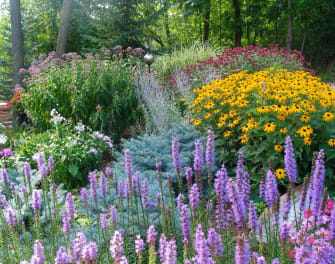Summer provides joy in different ways for all of us. For me, the longer days provide time in the garden and the fruits of my labor are abundant right now. Each year I plant a cutting garden that allows me to take flowers indoors. I get great joy by having flowers in the kitchen and living areas. Each week I fill a few mason jars and half a dozen bud vases to remind me why I plant flowers.

Although my cutting garden is primarily summer annuals with lots of Dahlias, Cosmos, Snapdragons, Sunflowers, and Zinnias, I enjoy using the summer perennials that are in full bloom right now. Echinacea, Black Eyed Susan, Gaillardia and Liatris are reliable cut flowers and I have them in my garden already to attract pollinators. I'm careful to leave more than enough for the birds, butterflies and bees.
A couple flowering shrubs that make great cutting flowers are Big leaf Hydrangeas (macropyhylla) and Roses. These flowers are staples in any florist and you may have them right out your back door. If you have White Hydrangeas, they're very effective for accenting the other colors and the Limelight Hydrangeas have huge flowers to fill any size vase. You don't have to rely on a formal rose garden to get cut flowers, the "shrub" roses (Knockouts, Brindabella, Fairy roses) all work well and they'll provide several blooms throughout the growing season.
If you want to start using perennials for cut flowers, see if you have Daylillies, Iris, Coreopsis or even Astilbe in your landscape; these are some of the popular varieties readily available and they provide flowers in mid-spring. One of the most beautiful cut flower arrangements I've done was a vase full of Pink Peony. I wait all year for the Peony to bloom and continue to plant them so I have more. Peony are maybe the most desired cut flower. If you avoid planting them because the bloom doesn't last long enough, you may want to reconsider. If you use them in arrangements I'm confident you'll appreciate them more.
Helleborus and Columbine (Aquilegia) are early blooming perennials that emerge in March/early April. They too are reliable as cut flowers and it's nice to have them as we emerge from winter weather. I have dozens of Columbine (low light) throughout my landscape and planted 6 Helleborus to enjoy over the next year.
As temperatures drop in September the selection may diminish but it's not a reason to stop cutting. Many summer flowers do continue into September and October. The desired Fall perennials include Chyrsathemum (coccineum & morfolium) and Helenium (Sneezeweed). Another popular cut flower is Asters which comes in several varieties. They grow wild along the sides of roads and they're great to use in an arrangement.
As you get comfortable using the flowers already available to you, consider planting more varieties. I'm providing a list of popular perennials that can be used for cutting arrangements. Give some thought to the time of year you want to use them and it's really as simple as selecting something you're attracted to. Not only are you increasing the amount of cut flowers you'll have; you're also enhancing your landscape. Remember that plant diversity is an important concept and "variety is the spice of life". Using plants that bloom during different times of year provides a rotation of continuous flowers and there's only one way to achieve this, plant more flowers.
Gardening is supposed to be fun, I hope this information expands the way you can enjoy your plants and hopefully it's an incentive to expand your gardens and plant more. Try experimenting with other annuals, tropicals and flowering shrubs as well. If they don't perform well, make note of it and try something else. There's no right or wrong when you're using cutting flowers, you just have to enjoy them.
Perennials For Cutting Flowers
- Acanthus spinosus
- Achillea filipendulina
- Achillea millefolium
- Aconitum napellus
- Anthemis tinctoria
- Aquilegia hybrida
- Armeria maritima
- Astilbe
- Aster
- Campanula persicifolia
- Centaurea cyanus
- Chrysanthemum coccineum
- Chrysanthemum morifolium
- Convallaria majalis
- Coreopsis lanceolata
- Coreopsis verticillata
- Delphinium elatum
- Dianthus caryophyllus
- Digitalis
- Dicentra eximia
- Dicentra spectabilis
- Doronicum cordatum
- Echinacea purpurea
- Erigeron speciosus
- Eupatorium
- Gaillardia x grandiflora
- Geum hybrids
- Gypsophila elegans
- Gypsophila paniculata
- Helenium autumnale
- Helleborus niger
- Heuchera
- Iris ensata
- Iris siberica
- Iris spusia
- Lavandula angustifolia
- Liatris
- Lilium
- Linaria purpurea ‘Canon J. Went’
- Lychnis chalcedonica
- Lobelia cardinalis
- Lupinus ‘Russell Hybrid’
- Monarda didyma
- Paeonia lactiflora
- Papaver orientale
- Penstemon
- Physostegia virginiana
- Platycodon grandiflorus
- Pyrethrum
- Rudbeckia
- Stokesia laevis
- Trollius europaeus
- Veronica spicata
